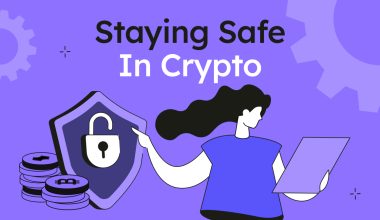Cryptocurrency has revolutionized the way we view money – that much can be said with certainty. It has also changed the way we manage our money by providing us with a unique mechanism – decentralization, as opposed to centralization. Custody vs. self-custody.
Unlike traditional banking systems, decentralization provides a trustless, distributed, and secure way to manage assets and send and receive payments. This is what is referred to as self-custody – because it is decentralized, no one has custody over your funds but you yourself.
However, centralization, or custodial management of funds, is still alive and well and crypto, and a popular choice for many investors. Custody, then, refers to the practice of entrusting a third-party service provider, such as an exchange or a wallet service, with your assets.
Custody and self-custody are two important concepts in the world of cryptocurrencies, and they play a crucial role in securing your digital assets. This is why they deserve a thorough explanation. This will let you pick the right model that corresponds to your investment needs and technical knowledge.
Let’s jump right into it.
Custodianship – entrusting someone else with your funds
Handing over control can be tempting. No one wants to think about safety all the time, right? You need a good night’s sleep, and delegating what you can to trusted parties can surely help with that.
This probably explains why custody is a popular choice for many cryptocurrency investors who prefer to have a professional service provider manage their digital assets. Custodial services, such as exchanges that offer centralized cryptocurrency wallets, are designed exactly in a way to provide users with a convenient way to store and manage their cryptocurrency assets.
Custodial crypto services and their upsides
Here are a few reasons why you might choose to use a custodian for your cryptocurrency holdings:
- It’s convenient: Custodial services can be very convenient if you don’t want to manage your own cryptocurrency wallet. Centralized providers do away with the more technical stuff and leave at the frontend only what matters, so the complexity of managing crypto is out of the window. These platforms have user-friendly, clean interfaces, that do not encumber you with technical talk or complicated operations. Importing wallets or manually enabling a crypto asset you want to buy can seem daunting at first. With a CEX, it’s all there for you to see, and operations usually take a few clicks.
- It’s secure (to a point): Centralized providers have significant resources at their disposal to ensure the security of your digital assets. They use more advanced security measures such as multi-factor authentication; they rely on encryption; and some of them use cold storages to protect their customers’ assets from theft or hacking.
Read more: Staying safe from scams in crypto
- Customer support: The importance of good customer support cannot be understated in crypto. Finding a platform with good client relations can solve a lot of problems quickly, ensuring that the service remains operational at all times.
- Regulatory Compliance: Custodians are often required to comply with regulations and are subject to audits and oversight by financial authorities. This can provide a level of confidence and assurance to users who are concerned about the legitimacy and safety of cryptocurrency transactions.
- Insurance: Some custodians offer insurance protection for their customers’ digital assets, which can provide an additional layer of protection against loss or theft. But you have to make a rule out of reading the fine print – the devil is in the details. Before putting your hard-earned money in a centralized wallet, always make sure to read their terms and conditions, as this can make all the difference.
Overall, using a custodian can provide peace of mind for users who are concerned about the security and management of their crypto.
But nothing is without risk.
Custodial crypto services and their downsides
While custodial wallets can provide convenience and user-friendliness, there are several risks associated with entrusting your digital assets to a third-party service provider. Here are some:
- Centralized control: While it may provide convenience and ease-of-use, it must be underlined that you are entrusting control of your digital assets to a third party. This means that the custodian has the power to freeze or confiscate your funds, block your transactions, or limit your access to your assets at a whim.
- Security breaches: Despite the advanced security measures implemented by custodial services, there is always a risk of a security breach. If the custodian’s security is compromised, your digital assets could be stolen or lost, and this has happened a number of times to centralized exchanges.
Read more: How to protect your crypto assets
- Operational errors: Custodian exchanges and wallets are run by humans, and mistakes can happen. If the custodian makes an error or goes bankrupt, you may lose access to your assets or experience delays in accessing them.
- Counterparty risk: When you use a custodial wallet, you are relying on the custodian to manage your assets properly. If the custodian engages in fraudulent activity, your assets could be at risk, and this is yet another dark and very real chapter in the history of crypto.
- Limited control: When you use a custodial wallet, you give up some control over your assets. For example, you may not be able to choose which blockchain your assets are stored on or access certain features that are only available to self-custody users.
It’s important to carefully consider these risks when choosing a custodial wallet and to do your research on the custodian’s security and reputation. You are entrusting them with your money, after all. It’s also a good idea to diversify your holdings across multiple wallets and exchanges.
Now, let’s go independent.
Self-custody, or: the advantages of being your own bank
Self-custody, as opposed completely to custody, involves holding and managing your cryptocurrency assets independently. You do not rely on a third-party service provider.
It’s like having your own private bank and safe, but without suffering from lack of functionality and connectivity.
Self-custody is achieved through the use of a decentralized, or non-custodial, cryptocurrency wallet. A wallet is a piece of software, most often a mobile app, that allows you to store, send, and receive cryptocurrency assets.
Read all about it: Introduction to crypto wallets and how to choose one
“Being your own bank” can have several advantages, provided you have the patience and a certain degree of technical expertise for it.
Advantages of self-custody
- Control: With self-custody, you have full control over your digital assets. You can choose which wallet to use, which blockchain to store your assets on, and when to buy, sell, or transfer your assets. This comes with a fair bit of responsibility – you are the only one who has access, but you are also the only one who can ensure the safety of your portfolio. You must take certain precautions in order to keep your DeFi wallet safe and sound, and away from prying eyes.
- Privacy: Self-custody can provide greater privacy than custodial services, because, most of the time, you don’t have to provide personal information or undergo identity verification to manage your assets. Your transactions are also not subject to surveillance by a third party – they are done directly on the blockchain, and, as such, no one has direct access to them, your data, passwords, or private keys.
Not sure how blockchains work? Read here: Blockchain explained: an introduction to distributed ledgers
- Security: While self-custody requires more technical expertise and effort than custodial services, it can also provide greater security – this is the trade-off. You are the only one responsible for securing your own private keys, which are used to access your digital assets. This can be done using hardware wallets or other secure storage solutions.
- Decentralization: Self-custody aligns with the principles of decentralization, which is a key aspect of the cryptocurrency ecosystem. By managing your own assets, you are contributing to the decentralization of the network. You are also reducing reliance on centralized intermediaries. This can lead to increasing dominance for the DeFi market as opposed to the centralized one, ushering in a new era for finance in general.
- Flexibility: With self-custody, you have the flexibility to use different wallets and exchanges to manage your assets, and can easily switch between them if needed. You are not locked into a single custodial service provider.
Overall, self-custody can provide greater control, privacy, security, and flexibility for users who are willing to put in the effort to manage their own digital assets.
Disadvantages of self-custody
While self-custody can provide significant advantages over custodial services, it also has some disadvantages and challenges to consider. Here are some of the key drawbacks of self-custody:
- Technical complexity: Self-custody requires more technical expertise than using a custodial service. Users need to understand how to protect their private keys, securely store their digital assets, and navigate wallets, exchanges, and bridges. The best way to acquire this technical knowledge is of course to dive into it – get a wallet and just start there by going around the interface, reading up on technical jargon, and… reading Changex Academy.
- Responsibility: With self-custody, users bear full responsibility for the security of their digital assets. This is both good and bad and whatever you make of it. You must realize that making a mistake, like losing your private keys or disclosing them to third parties, will likely result in the loss of your funds. With decentralized wallets, there is no insurance protection.
Read here: The beginner’s guide to cryptocurrency
- Time and effort: Managing your own digital assets can be time-consuming and requires ongoing effort. You need to stay up-to-date on security best practices, monitor your wallets for potential fraud or hacking attempts, and maintain backups of their private keys. You must also stay vigilant for any attempted scam attempts, and no doubt you will encounter them at some point – everyone does.
- Lack of customer support: While custodial services typically provide customer support and assistance, self-custody users are often left to troubleshoot issues on their own. This can be challenging for users who are not experienced in the technical aspects of cryptocurrency. However, not all non-custodial wallets are the same, and some do offer technical and customer support for their users.
Choosing the right model for you
Here are some actionable tips on how to choose between custody and self-custody in crypto:
- Understand the Risks: Before you choose between custody and self-custody, it’s important to understand the risks associated with both options. With custodial solutions, you are trusting a third party to keep your assets safe. This may make you vulnerable to hacks or other security breaches. With self-custody, you are responsible for keeping your assets safe, but at the cost of extra precautions.
- Consider Your Investment Strategy: Consider your investment strategy and how frequently you plan to buy or sell cryptocurrency. If you plan to actively trade, then custodial solutions may be more convenient for you. If you plan to hold your assets for the long-term, then self-custody may be a better option.
Read more here: How to choose an investment strategy in crypto.
- Determine Your Comfort Level: Determine your comfort level with technology and security. If you’re not comfortable with managing your own private keys or setting up a hardware wallet, then custodial solutions may be a better option for you. If you are comfortable with technology and are willing to take the time to learn about security best practices, then self-custody may be a good option.
- Research Your Options: Research different custody and self-custody options and compare their security features, fees, and ease of use. Popular custodial options include exchanges such as Coinbase, while popular self-custody options include software wallets like Trust wallet and Changex wallet, as well as hardware wallets such as Ledger or Trezor.
- Practice Good Security Habits: No matter which option you choose, it’s important to practice good security habits. This includes using strong passwords, enabling two-factor authentication, and keeping your private keys or recovery phrases in a safe place.
Conclusion
Custody and self-custody have their respective advantages and disadvantages, as all things. Custody is convenient and provides you with a higher degree of flexibility, while self-custody provides you with greater control and privacy. Define what matters to you, and it should be an easy choice.
Keep reading, keep learning – explore more of our resources below.






